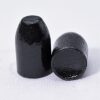I have to disagree with this. Given the same weight, bearing surface, diameter and charge weight, lead will produce higher velocities than jacketed not because of higher pressures but because lead has lower friction than a jacketed bullet. Lead may "bump up" to provide a better gas seal in the event that the two types are undersized for the groove diameter (or chamber throat in revolvers) to begin with. Try slugging the bore using comparable lead and jacketed bullets and gauge the difference in effort between the two.
This is a commonly held fallacy, but it is a fallacy. This is not an either-or scenario. Lead bullets both have lower friction as well as both being sized larger and bumping up more, both of which trap more pressure for a given charge weight. Even when you reduce the charge weight to equalize the pressure, the lead load will still produce a higher velocity. The increase in velocity is due to the lower friction, but you must indeed reduce the charge to avoid creating higher peak chamber pressure when repurposing jacketed or plated data for use with lead.
This is easily observed in published load data. Unfortunately there is little lead load data for 40S&W, so lets look at some 9mm luger, from the latest Western Powder load data:

We see at 115gr. the lead bullet takes less charge to reach ~34.4K PSI than all plated and jacketed 115s. The listed Barnes XPB is loaded to a lower pressure but it merits noting that solid-copper projectiles like it follow their own unique load data. The lower charge is required because the lead seals up better, trapping more pressure. The resultant velocity is also highest for the lead bullet. This is the effect of the lower friction. If friction was the dominant factor reducing it could only make less pressure, not more.
We see the same trend at 124gr, and to a lesser extent at 147. Sometimes the differences are small, sometimes they are not. But the overall trend is that lead takes less charge, so blindly applying plated or jacketed data to lead bullets is dangerous to do and nothing to recommend. Can you get away with it? In most cases yes. In some cases the charge ends up very close to the same. But there are cases in which the starting charge for a jacketed bullet is higher than the max charge for a lead counterpart.
Without any pressure test data of the lead bullet you need to reduce the charge weight given for jacketed or plated - but of course if you had pressure data on the lead you'd just use that.



